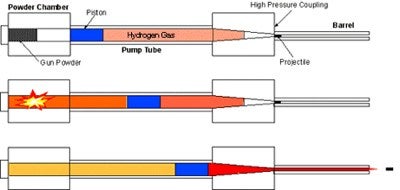The latest Popular Mechanics (Jan 2009) has an article about the 12 foot long vertical gun NASA has at the Ames Research Center. The gun is used to simulate impacts from meteor and space debris.
What is very interesting is that it utilizes a hybrid air gun / gun powder system. It uses a gunpowder charge to accelerate a piston which compresses hydrogen gas to 100,000 psi (maximum pressure of a .338 Lapua Magnum is 60,916 psi). This propels a saboted projectile at 26,400 fps!
The piston system if very common. All spring air guns use it, even the simple springer airsoft guns use a simple piston system. The difference is they use a spring to propel the piston which compresses air.
Here is my attempt at explaining my understanding of how the NASA gun works:

Excuse my drawing skills. Click to expand
UPDATE: A diagram by NASA of a Light Gas Gun (thanks to R.A.W and Billl):
I got it more or less correct 🙂
 Your Privacy Choices
Your Privacy Choices
